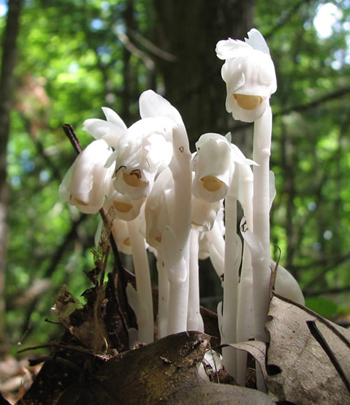Contents:
Common Names | Parts Usually Used | Plant(s) & Culture | Where Found | Medicinal Properties
Legends, Myths and Stories | Uses | Formulas or Dosages | Warning | Bibliography
Scientific Names

- Monotropa uniflora L.
- Heath family
Common Names
- Bird’s nest
- Bird’s nest root
- Convulsion-root
- Convulsion weed
- Corpse plant
- Dutchman’s-pipe
- Fairy smoke
- Fit plant
- Fit root
- Fit root plant
- Ghost flower
- Ice plant
- Nest root
- Ova-ova
- Pipe plant
Parts Usually Used
Root, whole plant
Back to Top
Description of Plant(s) and
Culture
Indian pipe is a unique perennial plant without chlorophyll; a mass of dark, brittle, saprophytic roots produces the ivory-white, waxy stem growing 4-10 inches high and covered with scaly bracts. The stem is topped by a single, nodding, white, pipe-bowl-shaped or bell-shaped flower which turns black when bruised. The whole plant is translucent white. Scalelike leaves nearly absent. Blooms June to October.
Back to Top
Where Found
Grows in dark, rich woods in the temperate and warmer parts of North America. Too scarce to harvest. Maine to the Carolinas, westward to Missouri.
Back to Top
Medicinal Properties
Antispasmodic, febrifuge, nervine, sedative, tonic
Back to Top
Legends, Myths and Stories
Once called “Ice plant” because it resembles frozen jelly, and “melts” when handled. Also called “Bird’s Nest”, in reference to the shape of the entangled root fibers.
Back to Top
Uses
A good remedy (root tea) for spasms, fainting spells, epilepsy, lockjaw, convulsions, sedative, muscle spasms, St. Vitus dance, and various nervous conditions and may be helpful in remittent and intermittent fever, takes the place of quinine and opium. Mixed with fennel seed, it makes a good eyewash, bunions, warts, gonorrhea, bladder problems, and vaginal douche for vaginal and uterine inflammations. The plant was soaked in rose water, then a cloth was soaked in the mixture and applied to the eyes. The roots are known to be a powerful emetic and one used by Native Americans.
Native Americans drank the tea for aches and pains due to colds.
Back to Top
Formulas or Dosages
Infusion: use 1 tsp. Indian pipe root and 1 tsp. fennel seed with 1 pint boiling water. Steep for 20 minutes and strain.
The powdered root: 1/2 tsp., 2-3 times per day.
Back to Top
Warning
Safety undetermined; possibly toxic. Contains several glycosides.
Back to Top
Bibliography
![]() Back to Eden
Back to Eden, by Jethro Kloss; Back to Eden Publishing Co., Loma Linda, CA 92354, Original copyright 1939, revised edition 1994
![]() Eastern/Central Medicinal Plants
Eastern/Central Medicinal Plants, by Steven Foster and James A. Duke., Houghton Mifflin Company, 215 Park Avenue South, New York, NY 10000
![]() The Herb Book
The Herb Book, by John Lust, Bantam Books, 666 Fifth Avenue, New York, NY. copyright 1974.
![]() Indian Herbalogy of North America
Indian Herbalogy of North America, by Alma R. Hutchens, Shambala Publications, Inc., Horticultural Hall, 300 Massachusetts Avenue, Boston, Massachusetts 02115, 1973
![]() Webster’s New World Dictionary
Webster’s New World Dictionary, Third College Edition, Victoria Neufeldt, Editor in Chief, New World Dictionaries: A Division of Simon & Schuster, Inc., 15 Columbus Circle, New York, NY 10023
